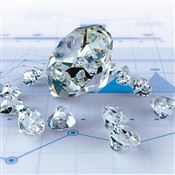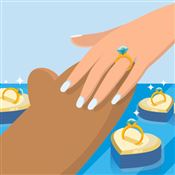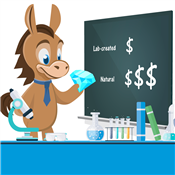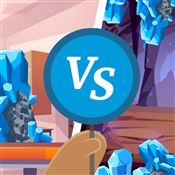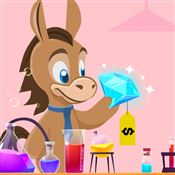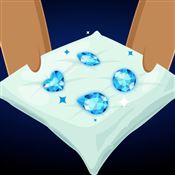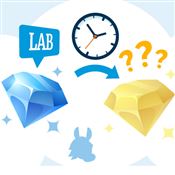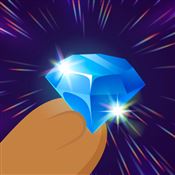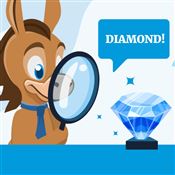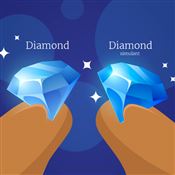Cubic Zirconia vs Diamond
Is cubic zirconia a good alternative to diamonds? While CZs are cheap, there are some downsides. Read on to see if it's the right choice for you.
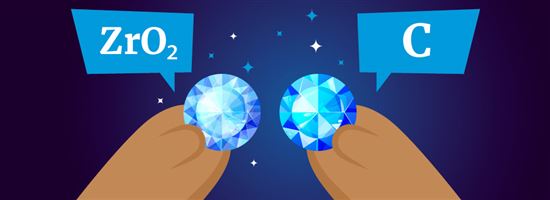 |
Love the look of diamonds, but can't justify the price tag? Cubic zirconia gives you the look at just a tiny fraction of the cost.
But although cubic zirconia and diamonds look alike, they're different in just about every way.
If you're considering CZ for your engagement ring, it's important to understand the differences. Is this faux diamond right for you? Below, an in-depth look at cubic zirconia vs diamonds.
What is Cubic Zirconia?
Cubic zirconia is made from a man-made material called zirconium dioxide. This is a crystalline material that is completely colorless and flawless. They can also be created in a whole range of colors to look like colored diamonds or other gemstones.
The first CZs were made in the 1960s for industrial use. In the 1970s, Soviet scientists found a way to grow them in labs. This started the mass commercial production of CZ for jewelry.
Because CZs are sparkly, durable, and cheap, they have become a popular diamond alternative for small budgets.
No, cubic zirconia is a man-made stone. Unlike moissanite or lab diamonds, it is not grown from a real, natural gemstone.
Pros and Cons of Cubic Zirconia
Pros:
- Very affordable - get your dream ring for less
- Looks like a diamond
- Very sparkly (high refractive index)
- A perfect "stone" - colorless and flawless
- Don't need to worry about losing it when traveling, etc.
Cons:
- Will get scratched up and cloudy
- Only lasts a few years
- No value at all
Some people also like CZs because they don't want to wear something so valuable on their finger.
Pros and Cons of Diamonds
Pros:
- Real gemstone
- Lasts for a lifetime; very hard and durable
- Better light performance
- Retains some value
- Can become a family heirloom
Cons:
- Much more expensive
- Environmental and ethical concerns about the mining industry
Is Cubic Zirconia Right For You?
A cubic zirconia engagement ring could be right for you if:
- You love the look of diamonds, but have a very tight budget. A CZ can help you get the ring of your dreams at a much more affordable price.
- You have other financial priorities. Want to buy a house or rather take the honeymoon of your dreams? Opting for a cheaper ring won't delay your other goals.
- You like to change things up. Can't decide on a style for the rest of your life? No worries. Since CZ rings are affordable, you can get a new CZ stone or even a completely new ring when you get bored.
- The thought of wearing an expensive diamond ring makes you nervous. A lot of people wear a less valuable CZ ring when traveling or doing other outdoor activities.
If you can relate to any of the above, keep reading to learn what makes CZs different.
Cubic Zirconia vs Lab Diamonds
A common misconception is that lab-created diamonds are the same as, or similar to, cubic zirconia. This could not be further from the truth.
Lab diamonds are identical to natural diamonds from the earth. They have the same physical and chemical properties. Therefore, they have the exact same look, durability, and light performance.
Lab diamonds are real diamonds in every way, just that the creation process is sped up in a lab environment. That's why the Federal Trade Commission does not advise calling them synthetic diamonds.
Cubic zirconia, on the other hand, only look like diamonds, but don't have the same properties. Because they're diamond simulants, they don't perform the same way. We'll get into this later.
Cubic Zirconia vs Diamonds Comparison
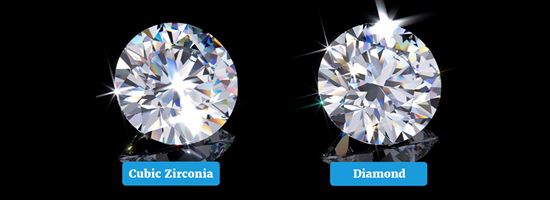 |
| Cubic Zirconia | Diamonds | |
|---|---|---|
| Creation | Man-made in labs | Formed over billions of years deep under the earth's crust (or made in labs) |
| Properties | Made of a man-made mineral zirconium dioxide | Made of carbon atoms |
| Look/Sparkle | More rainbow sparkle | More white sparkle |
| Hardness | 8.5 on the Mohs scale | 10 on the Mohs scale |
| Refractive Index | 2.15 - 2.18 | 2.417 - 2.419 |
| Color & Clarity | Perfectly colorless and flawless | Comes in a range of sizes and color and clarity grades |
| Pricing | Less than $20 per carat | $5,000 - $6,000 for a good value 1-carat natural diamond; $1,500 for lab-created |
| Value | Worth nothing | Retains some value |
| Fancy Color | Can be made in a variety of colors | Naturally colored diamonds are rare and expensive |
Bottom Line: If you want something affordable that looks like a diamond, cubic zirconia is a good alternative. But it won't last for a lifetime. If you want a special stone that will last or you can hand down, then a diamond is the better choice.
There are other middle-of-the-road diamond alternatives that provide better quality than CZ. Read 'til the end to see if one of those is a better fit for you.
No, it is very easy for a professional to tell the difference between cubic zirconia and diamond. They have completely different properties and perform in different ways.
Does Cubic Zirconia Look Like Diamonds?
Cubic zirconia appears white and sparkly just like diamonds. Most casual observers can't tell it's not real just by looking at your ring.
But if you place your CZ next to a diamond, you'll notice that it sparkles in a different way. Cubic zirconia emits more rainbow sparkles, instead of a diamond's white sparkles. It can look even more sparkly because the rainbow sparkles create a kind of a disco ball effect.
We'll cover a more in-depth discussion on sparkle in the next section.
Aside from sparkle, the cuts of a CZ also look different. Remember how they're softer than diamonds? This makes their edges rounder, compared to the sharper facets that diamonds have.
Cubic Zirconia vs Diamond Density & Durability
A diamond is forever, but not so for cubic zirconia.
Cubic zirconia ranks only 8.5 on the Mohs hardness scale . It's pretty durable for daily wear but still not hard enough to be scratch-proof. Over time, the surface can scratch and eventually look cloudy and dull.
You can't compare it to a diamond's durability. Diamonds are a perfect 10 on the scale, making them the hardest gemstone of all. If you take care of it, it should last a lifetime without getting scratched or cloudy.
But even if it's softer, cubic zirconia is heavier than a diamond. It has a higher density of 5.65 compared to a diamond's 3.52. If you have a CZ and a diamond of the same carat weight, the CZ stone will be smaller in size.
While cubic zirconia is durable enough for everyday wear, it will get scratched and cloudy over time. With normal everyday wear, a cubic zirconia wedding ring may last 2-3 years before becoming dull. With careful or occasional wear, it could last 5 years.
Cubic Zirconia vs Diamond Sparkle
The average person will find it hard to tell between cubic zirconia and diamonds based on sparkle. But you will notice subtle differences if you place them side-by side.
To understand this, here's how the two stones compare in the 3 components of light performance:
- Brilliance: Refers to the white light you see. Diamonds have a refractive index of around 2.42, compared to 2.15 - 2.18 for cubic zirconia. This means diamonds are more brilliant than CZs, though not by much.
- Fire: Refers to colored light you see. Fire is caused by dispersion. Cubic zirconia has a greater dispersion of 0.058 - 0.066, compared to 0.044 than diamonds. This is why CZs have a more intense rainbow sparkle.
- Scintillation: Refers to the flashes of light that reflect off the surface as you move it. Diamonds have incredible scintillation. Each facet dances with light. CZs don't have that kind of sparkle, especially under certain lighting conditions.
In short, diamonds are more brilliant, though cubic zirconia give off so much fire that it may seem more sparkly under certain lights. But as mentioned, this is probably not obvious unless you're comparing side-by-side.
It's okay to get water on your cubic zirconia jewelry. But over time, a lot of exposure to water will damage it. Harsh cleaners are also not good for the stone. So it's best to take off your CZ ring when cleaning, showering, swimming, etc.
Cubic Zirconia vs Diamond Color and Clarity
Cubic zirconia is created to be completely flawless and colorless. It's equivalent to IF on the diamond clarity scale and D on the diamond color scale. This is the highest grade possible.
When you buy CZ, you don't need to worry about looking for a good stone. Every stone is perfect.
Diamonds come in a range of clarity and color grades. Flawless and colorless stones are extremely rare. Most diamonds have natural flaws and contain traces of yellow.
The pricing for diamonds depends on their quality. The fewer flaws, the more expensive. The key is to find the best balance between cost and visual beauty.
The cubic zirconia stone itself will not tarnish. But the jewelry it's set in can. This diamond simulant is usually set in cheap metals like silver and stainless steel. These can tarnish with exposure to water and chemicals.
This is why we recommend upgrading to a platinum or gold ring if you plan to get a CZ engagement ring.
Cubic Zirconia vs Diamond Price and Value
Cubic zirconia costs almost nothing compared to diamonds. A good value 1-carat natural diamond costs around $5,000 - $6,000. A perfect 1 carat CZ costs less than $20.
As you increase in size, diamonds get exponentially more expensive. But cubic zirconia still pretty much remains just as cheap.
And while they're very inexpensive, cubic zirconia has no value at all. In a CZ ring, the only valuable portion is the metal part of the ring. The stone itself is not worth anything.
Diamonds, on the other hand, will hold some value. The resale market is pretty weak, but you can maybe get about 50% of the value back.
Still, you shouldn't see diamond jewelry as investments - unless you have an especially rare colored diamond, or large high-quality stone.
CZ is worth buying if your priority is saving money. A perfect 1-carat CZ will run you only about $20. However, don't buy CZ if you're hoping to retain some resale value or pass it on as a family heirloom.
How to Tell the Difference Between a Cubic Zirconia and Diamond
Only a jeweler or gemologist can accurately tell if your stone is a CZ. But you can try these tips on your own to take a good guess.
With the naked eye
The best way to tell a CZ from a diamond with the naked eye is through the sparkle. Remember the cheat code: a CZ emits rainbow sparkles instead of a diamond's white sparkles. You will spot this easier if you put the two stones side-by-side.
Skilled jewelers and gemologists can easily see this. But if you're a casual observer, telling the difference might be difficult. To the untrained eye, the two stones might look indistinguishable.
By doing tests
Still can't tell even after a thorough look? Try these tests at home for more clues. They will work best if you have both a CZ and a diamond next to each other.
- Fog test. Diamonds have better thermal conductivity. If you breathe on a diamond, the fog from your breath will dissipate almost immediately. If it's a CZ, the fog will stay on for a few seconds.
- Newspaper test. This works only for loose stones. Place your stone upside down on a newspaper. If you can read the print through the stone, that's likely a CZ. You shouldn't see the letters at all through a diamond since it has very high refractivity.
- Magnifying glass test. View your stones under a 10x magnifying glass. CZ stones are completely flawless and have rounded edges. Diamonds have natural inclusions and very sharp, precise edges.
- Weight test. Have a gem weighing scale and two loose stones of the same size? The CZ one should weigh around 1.6x heavier than the diamond.
Other Diamond Alternatives
Not sure if a cubic zirconia engagement ring is right for you? Here are some other diamond alternatives.
While they do cost more than CZ, the quality is better. Your ring will last longer. These are good middle-of-the-road options.
Lab-created diamonds
Lab diamonds have the same physical and chemical properties as those formed in the earth. They are in every way real diamonds, with the same hardness, brilliance, and light performance.
Because they're made in labs, the price can be up to 70% cheaper than a natural diamond of the same size and quality. A good value 1-carat lab-grown diamond costs around $1,500 - $1,800 (compared to around $5,500 for a natural diamond).
Moissanite
Moissanite is a white gemstone that looks very similar to diamonds. It was first discovered in a meteor crater. Now they're lab-grown, but it's still made from a real gemstone.
The main difference is that, similar to CZs, moissanite has more rainbow sparkle. It is more durable with a hardness of 9.25, so it won't scratch and get cloudy. You'll have a brilliant stone that'll last a lifetime.
Moissanite only costs about $600 for a 1-carat stone. It's one of the best diamond alternatives if you're looking for a real gemstone that's affordable and sturdy.
White sapphire
Sapphires come in many different colors. A white sapphire resembles a diamond in look.
You can find 1-carat white sapphires for less than $1,000 (and even cheaper for a lab-created stone). But it may not give you the brilliance you're looking for. Sapphires often appear a bit hazy. You'll have to see if it's a look you like.
Common Questions
Is cubic zirconia prettier than diamonds?
Cubic zirconia can appear more fiery than diamonds. They give off a more intense rainbow sparkle. This is totally up to your personal preference. Some people love the extra sparkle, while some may think it's a bit too "disco ball."
Why is cubic zirconia so cheap?
Cubic zirconia is cheap because they are man-made and mass produced by machines. They're not a natural gemstone.
Does cubic zirconia look cheap?
People will not be able to tell that a cubic zirconia ring is not a diamond. Especially if the CZ is in a nice gold setting, it will not look cheap. Usually, it's a cheaper, low quality setting that makes the ring look cheap, not the CZ.
Can you shower with cubic zirconia?
You shouldn't shower with cubic zirconia jewelry. Even though CZ itself won't turn green, the metal may if it's a cheaper material. In general, it's not a good idea to shower with fine jewelry, as the water and soap will cause it to dull.
Do cubic zirconia lose their sparkle?
Even though cubic zirconia is pretty durable, it will get scratched with daily wear and tear. Once the stone has a lot of scratches, it will start to look cloudy and lose sparkle.
Bottom Line
Cubic zirconia is a good alternative to diamonds for those on small budgets. But it can't be a complete diamond substitute.
The biggest downside is that CZs won't last a lifetime, as they will scratch. If you want to go this route, we recommend getting a proper setting. A durable ring will help protect it more - and plus, it'll look nicer and feel more special.
In the end, the choice comes down to what you value. CZ is a good choice if you want to save or aren't comfortable with wearing expensive jewelry every day. But if you want something that will last forever, then a diamond is better.
Anna G is a research director at CreditDonkey, a diamond jeweler comparison and reviews website. Write to Anna G at feedback@creditdonkey.com. Follow us on Twitter and Facebook for our latest posts.
|
|
| ||||||
|
|
|
